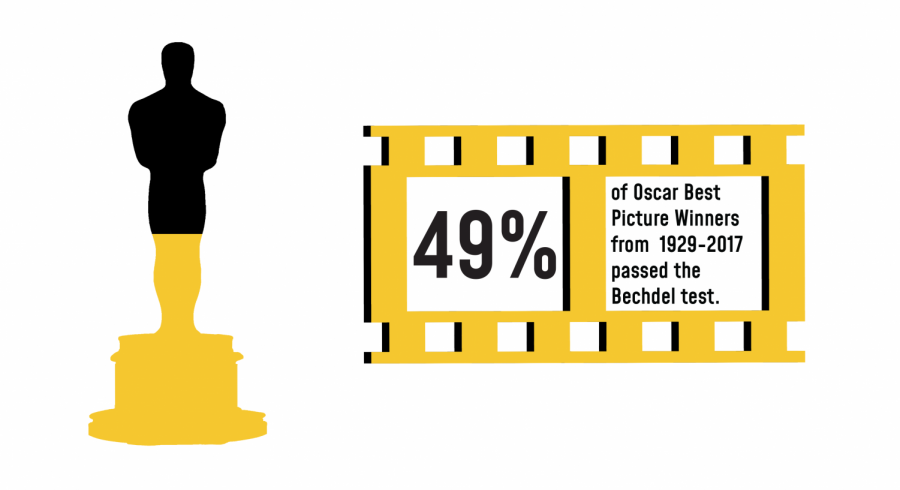The Oscar nominees for Best Director were the source of much controversy among film lovers this year since they solely consisted of men. According to the “2019 Celluloid Ceiling Report,” an annual study of female representation in films conducted by Dr. Lauzen at San Diego State University, female involvement in film is rare, not only in Oscar nominated movies but also in the other films of 2019. The study found that women made up only 20 percent of all behind the scenes workers in the top 100 films of 2019.
This discrepancy between the genders in film is not a new concept and extends beyond major motion pictures. Junior Ellie Watson, co-president of Film Club, said that she recently did an exercise in Film Club where every member, boy or girl, was given the task to create a character from scratch. All of them ended up creating male characters.
This much is clear: men are associated with films more often than women are. Perhaps for that reason, the Bechdel test was introduced. It first appeared in a 1985 comic by Alison Bechdel. For a movie to pass the Bechdel test it has to have two (preferably named) female characters who talk to each other about something other than a man.
Watson said she thinks the Bechdel test is a good idea in theory but is flawed in practice.
“I think that movies are a little subjective to apply [them] to one standard test, but I think it is a good way [of] opening the public’s eye to just how little female representation there is in scripts and movies,” Watson said.
Fine Arts and Psychology teacher Donna Walker said that she doesn’t believe the Bechdel test is an effective measure of female representation in film.
“I think you could have a movie that certainly empowers women and … doesn’t necessarily pass the meter of that test,” Walker said. “For example, a classic example is the movie ‘Gravity.’ Sandra Bullock is an astronaut floating alone in space, accomplishing amazing things and yet that film does not pass the Bechdel test.”
Similar to “Gravity,” some movies do not pass the Bechdel test simply because of their subject matter. For example, the Oscar nominated movie “1917” is about soldiers in WWI so there are very few females in the movie at all. Yet, senior and frequent film reviewer Josh Lefkowitz says that these types of movies are not problematic.
“Every movie has a thesis,” Lefkowitz said. “If a movie that doesn’t pass the Bechdel test is within a completely separate thesis that isn’t really referring to feminism within its concept, I don’t think it’s necessarily anti-feminist.”
Ultimately, the Bechdel test only assesses female characters’ actions in scripts. There is no mention of women in the film industry working behind the camera, which Walker said is a better indicator of female representation.
The “2019 Celluloid Ceiling Report” found that women made up only 27 percent of producers, 19 percent of writers and 13 percent of directors in the top 250 grossing films of 2019. Walker and Watson agree that they would like to see more female directors in particular.
“There’s not a crazy amount of female directors,” Walker said. “One, it’s really super crazy hard for females to break into directing… Two, there’s less females actually attempting to break into directing.”
Watson herself said that she wants to move to L.A. and create films but is afraid of not being taken seriously in an industry that is dominated by men. The question becomes, what can be done to encourage more women to pursue a career in film?
“I would love to see more women making films [and] going to film school,” Watson said. “I think the way to solve [this problem] is [to] create more programs and catalyze more women to go to film school if that’s what they love to do.”
Furthermore, Watson said that females in the film industry aren’t given as much recognition as men which makes it harder for women to succeed. Lefkowitz said that men in the industry have a responsibility to help women get the recognition they deserve.
“If you are a male writer or male director, [you can] give female actors and female technicians the opportunity to shine and really show their passion and their craft [which] for the majority of Hollywood history, we haven’t been able to showcase,” Lefkowitz said.
Walker said that she doesn’t believe in superficially adding female characters or scenes to films just to fulfill the Bechdel test but improvements to female representation in films tend to occur naturally.
“Older women in film in the 80s and 90s felt very discriminated against,” Walker said. “There were very few roles … for women over the age of 50, and it was a problem. So guess what? People started writing more roles. … Now, over the last 5 years, we’ve seen a significant uptick in roles for older actresses.”
Women are still in the minority in most parts of the film industry, yet there is hope for improvement. The road to female equality in film might be a long one, but concrete steps towards increasing female contributions can and already have been taken.
















